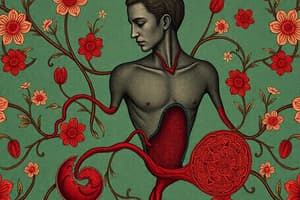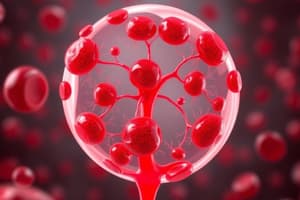Podcast
Questions and Answers
What is the natural anticoagulant found in the body?
What is the natural anticoagulant found in the body?
- Heparin (correct)
- Warfarin
- Aspirin
- Clopidogrel
What is the primary benefit of the biconcave shape of erythrocytes?
What is the primary benefit of the biconcave shape of erythrocytes?
- Ability to produce hemoglobin
- Increased surface area to volume ratio (correct)
- Increased lifespan in circulation
- Optimized oxygen storage capability
What causes anemia in the human body?
What causes anemia in the human body?
- High levels of white blood cells
- Increased red blood cell production
- Blood loss or reduced hemoglobin levels (correct)
- Excessive oxygen transport
Which of the following leukocytes are involved in combating parasites?
Which of the following leukocytes are involved in combating parasites?
What is the main function of hemoglobin in the blood?
What is the main function of hemoglobin in the blood?
What is the term for the process of producing red blood cells?
What is the term for the process of producing red blood cells?
Why is a differential WBC count more informative than a total WBC count?
Why is a differential WBC count more informative than a total WBC count?
What type of cell is referred to as a 'committed cell'?
What type of cell is referred to as a 'committed cell'?
What is saltatory conduction?
What is saltatory conduction?
Which of the following is NOT directly involved in the production of a typical spinal reflex?
Which of the following is NOT directly involved in the production of a typical spinal reflex?
Which division of the nervous system controls smooth muscle and internal organs?
Which division of the nervous system controls smooth muscle and internal organs?
Which division of the nervous system controls both voluntary and involuntary skeletal muscle movement?
Which division of the nervous system controls both voluntary and involuntary skeletal muscle movement?
Which division of the nervous system predominates during the relaxed state?
Which division of the nervous system predominates during the relaxed state?
What effect does the sympathetic nervous system facilitate?
What effect does the sympathetic nervous system facilitate?
What are the membranes that enclose the central nervous system called?
What are the membranes that enclose the central nervous system called?
Which region of the brain coordinates antagonistic muscle movements?
Which region of the brain coordinates antagonistic muscle movements?
Which of the following statements about muscle contraction is true?
Which of the following statements about muscle contraction is true?
What initiates the contraction of a skeletal muscle cell?
What initiates the contraction of a skeletal muscle cell?
Which statement is NOT necessary for muscle contraction to occur?
Which statement is NOT necessary for muscle contraction to occur?
Once ATP is depleted in a muscle cell, what will it use next for energy?
Once ATP is depleted in a muscle cell, what will it use next for energy?
What is the primary energy source used by muscle cells to generate ATP?
What is the primary energy source used by muscle cells to generate ATP?
What happens when an electrical impulse reaches a neuromuscular junction?
What happens when an electrical impulse reaches a neuromuscular junction?
Which of the following is NOT a function of bone?
Which of the following is NOT a function of bone?
Where is compact bone primarily located in long bones?
Where is compact bone primarily located in long bones?
What is the primary function of erythrocytes?
What is the primary function of erythrocytes?
Which component of blood plasma is involved in the regulation of osmotic pressure?
Which component of blood plasma is involved in the regulation of osmotic pressure?
What occurs during the platelet phase of haemostasis?
What occurs during the platelet phase of haemostasis?
How many oxygen molecules can a single hemoglobin molecule transport?
How many oxygen molecules can a single hemoglobin molecule transport?
Which type of leukocyte is primarily responsible for an immune response through antibody production?
Which type of leukocyte is primarily responsible for an immune response through antibody production?
What is a primary component of plasma that helps in the clotting process?
What is a primary component of plasma that helps in the clotting process?
Which of the following statements about leukocytes is correct?
Which of the following statements about leukocytes is correct?
What vital factor is necessary for erythropoiesis to proceed effectively?
What vital factor is necessary for erythropoiesis to proceed effectively?
Which phase of haemostasis involves the transformation of prothrombin to thrombin?
Which phase of haemostasis involves the transformation of prothrombin to thrombin?
What type of blood cell is characterized by a lack of granules and plays a role in phagocytosis?
What type of blood cell is characterized by a lack of granules and plays a role in phagocytosis?
What is the role of erythropoietin in erythrocyte production?
What is the role of erythropoietin in erythrocyte production?
Which protein helps to maintain blood clotting by converting fibrinogen to fibrin?
Which protein helps to maintain blood clotting by converting fibrinogen to fibrin?
During which phase of erythropoiesis is hemoglobin and iron accumulated?
During which phase of erythropoiesis is hemoglobin and iron accumulated?
Which type of leukocyte is primarily involved in fighting parasitic infections?
Which type of leukocyte is primarily involved in fighting parasitic infections?
What is the primary role of tendinous muscle attachments compared to direct attachments to bone?
What is the primary role of tendinous muscle attachments compared to direct attachments to bone?
Which type of joint is characterized by being immovable?
Which type of joint is characterized by being immovable?
What is a defining characteristic of rheumatoid arthritis?
What is a defining characteristic of rheumatoid arthritis?
Which of the following best describes the function of the fixator muscle?
Which of the following best describes the function of the fixator muscle?
In the sliding filament model of muscle contraction, what role does calcium play?
In the sliding filament model of muscle contraction, what role does calcium play?
What type of muscle fiber arrangement is classified as short and containing many fibers per unit area?
What type of muscle fiber arrangement is classified as short and containing many fibers per unit area?
Which joint type allows for the greatest range of motion?
Which joint type allows for the greatest range of motion?
What is an example of a first-class lever in the human body?
What is an example of a first-class lever in the human body?
Which connective tissue layer surrounds the entire muscle?
Which connective tissue layer surrounds the entire muscle?
What is the main role of the sarcoplasmic reticulum?
What is the main role of the sarcoplasmic reticulum?
Which type of muscle interaction opposes the movement initiated by the prime mover?
Which type of muscle interaction opposes the movement initiated by the prime mover?
What happens to tropomyosin when calcium levels increase in muscle tissue?
What happens to tropomyosin when calcium levels increase in muscle tissue?
What is the primary function of muscle tissue regarding heat?
What is the primary function of muscle tissue regarding heat?
Flashcards are hidden until you start studying
Study Notes
Blood Function and Composition
- Blood is a specialized connective tissue with various critical functions:
- Distribution of oxygen (O2), waste products, hormones, and nutrients.
- Regulation of pH, temperature, and fluid levels.
- Protection through clotting processes and immune responses.
- Composed of:
- Plasma: Non-living fluid matrix; approximately 90% water.
- Formed elements: Living blood cells including erythrocytes, leukocytes, and thrombocytes.
- Plasma contains fibrous proteins visible during clotting.
Blood Plasma Components
- Over 100 dissolved solutes found in plasma including:
- Proteins: Albumin, globulins (transport proteins and antibodies), clotting proteins (fibrinogen, prothrombin).
- Non-proteins: Urea, lactic acid, creatinine.
- Nutrients: Carbohydrates, amino acids, fatty acids, glycerol, vitamins.
- Electrolytes: Sodium (Na+), potassium (K+), calcium (Ca2+), magnesium (Mg2+), chloride (Cl-), bicarbonate (HCO3-).
- Gases: Respiratory gases O2 and CO2.
- Other: Enzymes, antigens, antibodies, hormones.
Formed Elements of Blood
- Refers to cellular components of blood:
- Erythrocytes (red blood cells) which are incomplete cells.
- Leukocytes (white blood cells) which are complete cells functioning in immunity.
- Thrombocytes (platelets) are disc-shaped cellular fragments involved in clotting.
- Formed elements originate from red bone marrow tissue.
Erythrocytes (Red Blood Cells)
- Erythrocytes have a diameter of 7.5 μm and a biconcave shape for enhanced gas transport.
- Mature erythrocytes are bound by a plasma membrane, lack a nucleus, and contain no organelles while being rich in hemoglobin (Hb).
- Main function includes transporting CO2 (~20%) and O2 (~90+%).
Erythrocyte Formation
- Erythrocytes are formed in red bone marrow under the control of erythropoietin.
- The three main phases of formation include:
- Haemocytoblast (stem cell) to proerythroblast (committed cell) leading to developmental pathways involving ribosome synthesis, hemoglobin accumulation, and nucleus ejection.
- Requires Vitamin B12 for stem cell division.
Hemoglobin Function
- Hemoglobin binds reversibly with oxygen and consists of four polypeptide chains.
- Each heme group contains an iron atom that binds one O2, allowing one Hb molecule to transport four O2.
- Oxygen loading occurs in lungs forming oxyhemoglobin, while unloading in tissues produces deoxyhemoglobin; also participates in CO2 transport.
Leukocytes (White Blood Cells)
- Leukocytes are spherical with sizes ranging from 10-24 μm.
- Classified into granulocytes (with granules) and agranulocytes (without granules):
- Granulocytes: Neutrophils (bacteria), eosinophils (parasitic worms), basophils (inflammation mediators).
- Agranulocytes: Lymphocytes (immune function) and monocytes (migratory phagocytes).
- Principal function: Defense against disease such as bacteria, viruses, and toxins.
Thrombocytes (Platelets)
- Thrombocytes are cell fragments 2-4 μm in diameter, with a rough disc shape and lack a nucleus.
- Mature platelets age rapidly, degenerating within 10 days if unused.
- Rich in granules that aid in clotting processes, particularly serotonin.
- Their chief function is to initiate blood clotting when injury occurs.
Hemostasis (Blood Clotting)
- Defined as cessation of bleeding with a framework for tissue repair.
- Occurs in response to damaged blood vessels through three phases:
- Vascular Phase: Contraction of the vessel wall (vasoconstriction).
- Platelet Phase: Platelet adhesion and aggregation forming a plug.
- Coagulation Phase: Fibrin formation leading to a stable clot.
Anticoagulants
- Anticoagulants are substances that inhibit blood clotting.
- Heparin is the body's natural anticoagulant, contrasting with Warfarin.
Muscle Structure and Function
- Muscle tissue consists of over 600 muscles with four primary functions: movement, posture, stabilization of joints, and generation of heat.
- Muscle characteristics include excitability, contractility, extensibility, and elasticity.
- Muscles are classified by fiber arrangements: parallel, convergent, pennate, circular.
Muscle Interactions and Attachments
- Muscles attach to bones via tendons, with each muscle having an origin (immovable) and an insertion (movable).
- Interactions between muscles include prime movers (major force), synergists (assist in action), antagonists (oppose movement), and fixators (stabilize origin).
- Muscles can only pull, never push.
Lever Systems in Muscle Mechanics
- Levers consist of a fulcrum, effort, and load.
- There are three types of bone-muscle levers:
- First Class: Effort and load are opposite.
- Second Class: Load is between effort and fulcrum.
- Third Class: Effort is between load and fulcrum.
Muscle Contraction Mechanism
- At the neuromuscular junction, motor neuron impulses induce calcium influx and the release of acetylcholine (ACh), stimulating muscle contraction.
- The sarcoplasmic reticulum releases calcium which binds to troponin, removing tropomyosin, thereby exposing actin binding sites for myosin binding.
Sliding Filament Model
- Thick (myosin) and thin (actin) filaments interact to shorten the muscle during contraction.
- Requires ATP for muscle contraction, with glycogen primarily serving as an energy source post-ATP depletion.
Importance of Blood Studies
- Blood studies can reveal specific changes in formed elements or plasma constituents, signaling different disease states.
Differential WBC Count vs. Total WBC Count
- A differential WBC count provides the percentage of each type of white blood cell, aiding in identifying specific pathologies.
Studying That Suits You
Use AI to generate personalized quizzes and flashcards to suit your learning preferences.




